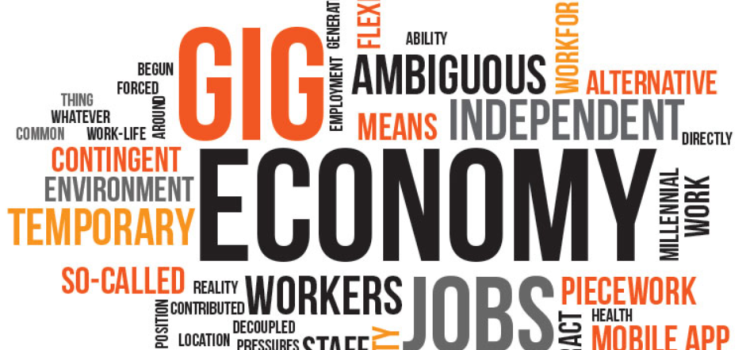
The gig economy, characterized by flexible, short-term, and freelance work arrangements, has undergone significant transformation over the past few decades. This evolution has been driven by technological advancements, shifting economic landscapes, and changing societal attitudes towards work. In this article, we will explore the origins, growth, and future prospects of the gig economy, providing an informative overview of this dynamic and increasingly prevalent sector.
Origins and Early Development
The concept of gig work is not entirely new. Historically, many professions operated on a freelance basis, including musicians, artists, and craftsmen. However, the modern gig economy began to take shape in the late 20th century, coinciding with the rise of the internet and digital technologies.
In the 1990s, the advent of the World Wide Web and the proliferation of personal computers created new opportunities for remote work and freelance projects. Websites like Craigslist and eBay emerged as early platforms where individuals could offer services or sell goods on a temporary basis. This period marked the beginning of a shift towards a more flexible and decentralized workforce.
The Rise of Digital Platforms
The true catalyst for the gig economy’s rapid expansion came with the development of digital platforms designed specifically to connect freelancers with clients. Companies like Upwork (formerly Elance-oDesk), TaskRabbit, and Fiverr revolutionized the way people found and performed gig work. These platforms provided a streamlined process for matching workers with short-term assignments, often leveraging user reviews and ratings to build trust and credibility.
The launch of ride-sharing services like Uber and Lyft in the early 2010s further accelerated the gig economy’s growth. These platforms not only offered a new way for individuals to earn money but also demonstrated the potential for gig work to disrupt traditional industries. The success of Uber and Lyft inspired a wave of innovation, leading to the creation of similar on-demand services in various sectors, including food delivery (e.g., DoorDash, Grubhub) and home services (e.g., Handy, Thumbtack).
Economic Factors and Workforce Demographics
Several economic factors have contributed to the gig economy’s expansion. The 2008 financial crisis, for example, resulted in widespread job losses and economic uncertainty, prompting many individuals to seek alternative sources of income. Gig work provided a viable solution for those in need of immediate employment, as well as for individuals looking to supplement their primary income.
Additionally, the gig economy has attracted a diverse range of workers. Millennials and Generation Z, in particular, have shown a strong preference for flexible work arrangements that allow for greater autonomy and work-life balance. This trend has been further amplified by the COVID-19 pandemic, which forced many people to reconsider traditional employment models and explore remote and freelance opportunities.

Technological Advancements
Technological advancements have played a crucial role in shaping the gig economy. The proliferation of smartphones and mobile apps has made it easier than ever for individuals to access gig work opportunities. Gig workers can now find, accept, and complete assignments with just a few taps on their devices.
Moreover, advancements in artificial intelligence (AI) and machine learning have enabled gig platforms to optimize their matching algorithms, ensuring that workers are paired with tasks that align with their skills and preferences. These technologies have also facilitated more efficient payment processing, dispute resolution, and performance tracking, enhancing the overall user experience for both workers and clients.
Challenges and Criticisms
Despite its many benefits, the gig economy has faced criticism and challenges. One of the primary concerns is the lack of job security and benefits for gig workers. Unlike traditional employees, gig workers typically do not receive health insurance, retirement plans, or paid leave. This has raised questions about the long-term sustainability of gig work and the potential for worker exploitation.
In response to these concerns, some governments and regulatory bodies have begun to implement measures aimed at protecting gig workers. For example, California’s Assembly Bill 5 (AB5) sought to reclassify certain gig workers as employees rather than independent contractors, thereby entitling them to additional benefits and protections. However, the implementation of such regulations has been met with resistance from gig companies, highlighting the ongoing debate over the classification and rights of gig workers.
The Future of the Gig Economy
Looking ahead, the gig economy is poised for continued growth and evolution. Several trends and developments are likely to shape its future trajectory:
- Increased Regulation: As the gig economy becomes more entrenched, governments around the world are likely to introduce more comprehensive regulations to protect gig workers’ rights. This may include measures to ensure fair wages, access to benefits, and protections against unfair termination.
- Technological Innovations: Advances in technology will continue to drive the gig economy’s evolution. AI and machine learning will play an increasingly important role in optimizing gig platforms, while blockchain technology may offer new solutions for secure and transparent payment processing.
- Industry Diversification: While the gig economy has traditionally been associated with sectors like transportation and delivery, it is likely to expand into new industries. Professional services, healthcare, and education are among the sectors that may see increased gig work opportunities in the coming years.
- Worker Empowerment: As gig workers become more organized and vocal, we can expect to see greater efforts to improve working conditions and ensure fair treatment. Worker cooperatives, unions, and advocacy groups will play a key role in driving these changes.
- Hybrid Work Models: The lines between traditional employment and gig work may continue to blur, with more companies adopting hybrid work models that combine elements of both. This could lead to new opportunities for workers to enjoy the benefits of flexibility while still accessing some level of job security and benefits.
Conclusion
The gig economy has come a long way since its early days, evolving into a significant and influential component of the modern labor market. While it offers numerous advantages, including flexibility and autonomy, it also presents challenges that must be addressed to ensure fair and sustainable working conditions. As technology continues to advance and societal attitudes towards work evolve, the gig economy is likely to undergo further transformation, shaping the future of work in ways we can only begin to imagine.








